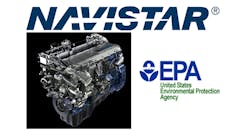The Environmental Protection Agency has submitted a final rule to the Office of Management and Budget (OMB) for review that outlines non-conformance penalties to allow Navistar to continue selling its MaxxForce engines until it can get certification of its own engines to meet EPA 2010 limits or begin incorporating Cummins engines into its vehicle lineup, expected in January 2013.
The contents of the rule are still unknown as it has yet to be formally published, according to OMB. Even Navistar itself does not know what those penalties are, said a spokesperson.
“Navistar is encouraged by the submittal of the final rule to (the Office of Management and Budget) and we hope that it generally mirrors what was in the interim rule,” Navistar spokeswoman Karen Denning told Reuters in a story posted on ChicagoTribune.com.
The previous interim rule was thrown out by the U.S. Court of Appeals for the District of Columbia Circuit. The court, ruling on a lawsuit brought by Navistar competitors Cummins Inc.; Daimler Trucks North America and its subsidiary Detroit Diesel; and by sister OEMs Mack Trucks and Volvo Trucks North America, said EPA erred when it issued a rule allowing Navistar to pay non-conformance penalties (NCP) on engines sold that do not meet EPA 2010 emissions rules requiring less than 0.20 grams of NOx.
The other OEMs argued that EPA should have conducted a public-comment process before issuing its interim rule. The court agreed.
“EPA took this action without providing formal notice or an opportunity for comment, invoking the ‘good cause’ exception provided in the Administrative Procedure Act (APA),” said Circuit Judge Janice Brown in her ruling. “Because we find that none of the statutory criteria for ‘good cause’ are satisfied, we vacate the IFR.”
Brown noted that the EPA interim rule “does not stave off any imminent threat to the environment or safety or national security. It does not remedy any real emergency at all, save the 'emergency' facing Navistar’s bottom line…Simply put, [Navistar] bet on finding a way to make exhaust gas recirculation a feasible and compliant technology before its finite supply of credits ran out. Navistar’s day of reckoning is fast approaching: its supply of credits is dwindling and its engines remain noncompliant.”
Navistar and EPA argued that the company needed the non-conformance penalties to allow it to continue selling engines until it could get its own engines certified.
In February, Navistar told analysts that it expected to avoid paying non-conformance penalties for not meeting 2010 emissions standards after submitting its MaxxForce 13L engine for EPA approval.
“My impression from the meeting is that they don’t intend to pay any fines, since they submitted their 13L engine” for certification, Walter Liptak, an analyst with Barrington Research Associates in Chicago, who attended the Navistar event, told Fleet Owner at the time. “They sell a lot of that engine and if they get it certified, they will use their remaining credits for their 11L and 15L product until they run out.”
Liptak noted that Navistar executives said they expected to submit both the 11L and 15L products to the EPA for certification “in early spring.”
The penalties were said to be up to $2,000 per heavy-duty engine.
But those Navistar engines were never certified, leading to a series of recent events that culminated with last week’s announcement that the company would purchase an “aftertreatment system” from Cummins which it will add to its MaxxForce engines to create a technology it is calling In-Cylinder Technology Plus (ICT+), aka selective catalytic reduction technology.
Navistar also said it is going to sell Cummins 15L engines beginning in January 2013 while it transitions its MaxxForce engines.
Navistar said that during its transition, it will continue to build and ship current model EPA-compliant trucks in all vehicle classes using appropriate combinations of earned emissions credits and/or non-conformance penalties (NCPs). The company added that it “continues to have productive discussions with the EPA and the California Air Resources Board (CARB) regarding its transition to ICT+.”
“The actions announced today establish a clear path forward for Navistar and position the company to deliver a differentiated product to our customers and provide a platform for generating profitable growth," Daniel C. Ustian, Navistar chairman, president & CEO, said last week.
A final agreement with Cummins, however, remained up in the air last week after a Cummins spokesperson told Fleet Owner that “after Navistar approached us to initiate discussions, we signed a memorandum of understanding, confirming our intent to further negotiate details to supply engines and heavy duty aftertreatment systems. The basic terms of the MOU include supply of the ISX15 engine and of aftertreatment systems from Cummins Emission Solutions. The MOU signifies our intent to negotiate a supply agreement. However, until all details are agreed upon, such an agreement is not considered final.”
As part of the announcement last week, Navistar also noted in a statement that it is cooperating with a Securities and Exchange Commission inquiry into accounting and disclosure matters. While the company did not identify what those matters are, it said it is “cooperating fully with this request” and had already turned over some paperwork related to the inquiry.
Navistar is also trying to secure a $1 billion loan from several banks with a meeting to finalize that agreement this week.
And just yesterday, Crains Business Chicago reported that the company is offering buyouts and considering layoffs as it looks to cut expenses. Crains, citing Dunning, said any salaried full-time employee is eligible.
“That is the last lever,” Denning said. “The number of people cut is contingent on the success in other areas.”



